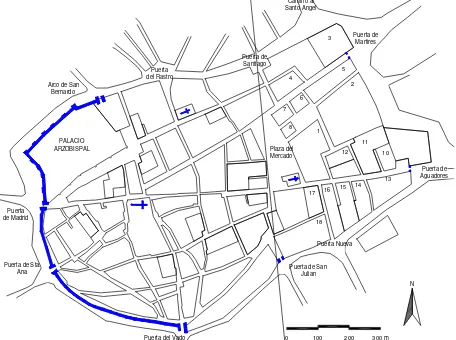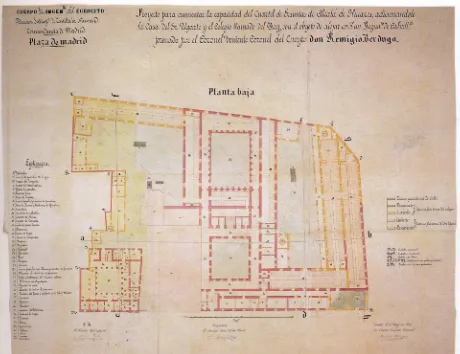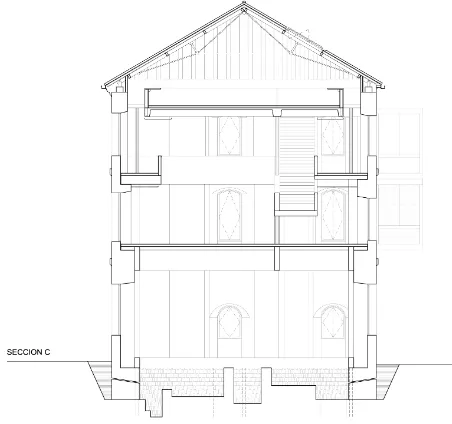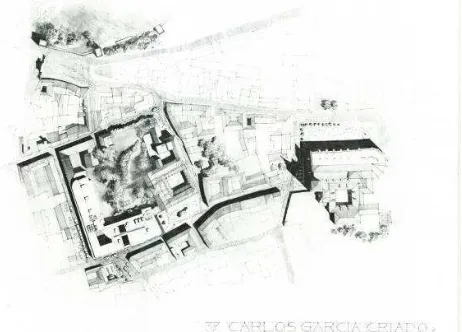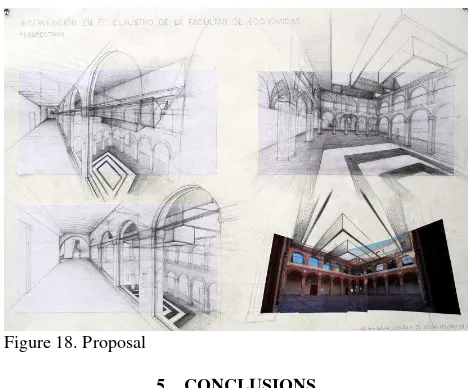THE UNIVERSITY OF ALCALA DE HENARES (MADRID, SPAIN), AS A DYNAMIC
EXAMPLE AND LABORATORY OF THE RECOVERY, REHABILITATION, AND
CONSERVATION OF THE CULTURAL
HERITAGE
Ernesto Echeverría Valiente a, *, Fernando da Casa Martín a, Flavio Celis D’amicoa, Pilar Chias Navarroa
a Department of Architecture, School of Architecture. Universidad de Alcalá, Calle Santa Úrsula 8, 28801 Alcalá de
Henares, Madrid, España, - ([email protected], [email protected], [email protected], [email protected])
CIPA Task Group 2
KEY WORDS: Architecture, Cultural Heritage, Representation, University of Alcala, Cartography, GPS.
ABSTRACT:
Cardinal Cisneros launched in 1499 a major universitary project, that was located in Alcala de Henares (Madrid, Spain). It bestowed
recently the recognition of the Council of Europe as a World Heritage Site in 1998 by UNESCO.
Cisneros created the new university in the vicinity of the Roman town of Complutum. This site had two qualities which were particularly important: it was placed at a safe distance from the power of the Crown at Toledo, and it was well connected to with other main Spanish cities, through the Roman road or calzada that crossed the Iberian peninsula from South to North going along
some important settlements as Mérida, Toledo, Zaragoza, and Barcelona.
Thus the old town of Alcala de Henares still keeps the remains of the Visigothic, Roman, Muslim and Hebrew cultures.
Since the end of the fifteenth century the built Renaissance complex has gone through three clear stages, where lots of relevant architects developed their work. Among them, Pedro Gumiel and Rodrigo Gil de Hontañón can be cited for their first drawings, but other anonymous architects have also contributed to build such an interesting project.
In a second stage some repairs were needed on the former structures, in order to adapt them to their new functions due to deterioration or even to changes in ownership or uses (as happened to the Colegio Mayor de San Ildefonso). Finally, at the latest
stage at the end of the 20th and the early 21st centuries a new regeneration project took place in order to introduce the modern technologies and energy-efficient standards the old universitary buildings.
An interesting example of this modern practices on dynamic conservation of the historical heritage is the new Learning and Research Center (LRC) on the ruins of San Diego headquarter built in 1859 on the site of the Franciscan convent of Santa Maria de
Jesus, founded in 1445 by Archbishop Alonso Carrillo (which in turn it replaced an earlier one).
The aims of the new LRC are to, preserve and document the archaeological remains from each one of the previous cultures, thus becoming an international research center on the cultural heritage documentation and preservation which heads the Spanish and European universities.
In short, it intends to add value to the existing Heritage through a new project which involves not only an intensive use but a transdisciplinary complex including urban, architectural and functional changes which have been solved through a comprehensive rehabilitation project, a special urban development and a master action plans with focus in energy –efficient researches.
Since the creation of the Schools of Architecture and Civil Engineery, the study of Built Heritage at the University of Alcala has been introduced as an essential educational tool, who can currently learn and apply both the traditional measurements and the digital invasive and non-invasive technologies (Such as X-Ray, radar or infrared methodologies) to study the old buildings, their constructive pathologies, and their evolution.
Teachers also show to the students the possibility of including new and changing uses the old buildings, and they explore new proposals on this heritage.
1. INTRODUCTION
Cardinal Cisneros launched in 1499 a major universitary project, that was located in Alcala de Henares (Madrid, Spain).
Alcala University is among the four universities that have the recognition of the Council of Europe as a World Heritage Site by UNESCO (1998) along with those of Virginia (1987), Caracas (2000), and U. Autonoma de Mexico (2007)
1.1 The foundation of the University of Alcalá
After the Middle Ages begins the foundation of many Univerisities in Spain and in Europe (Aguadé, 1993). After a
previous attempt, (Alvar, 1996) Cisneros created the new university in the vicinity of the Roman town of Complutum. This site had two qualities which were particularly important: it was placed at a safe distance from the power of the state at Toledo, and it was well connected to other main Spanish cities, as it was on the Roman road or “calzada” crossed the Iberian
peninsula from South to North across some important settlements as Mérida, Toledo, Zaragoza, and Barcelona.
1.2 Location
The old town of Alcala de Henares still keeps the remains of the Visigothic, Roman, Muslim and Hebrew cultures.
VIA ROMANA
Figure 1. Overlap of different core locations on the current plane of Alcalá
2. DEVELOPEMENT OF UNIVERSITY
2.1 The beginning
The university town planned by Cisneros will be built to the east of the walled city of Alcala, expanding the walled to increase its surface almost twice the XIV century city.
Since the end of the fifteenth century the built of Renaissance complex has gone through three clear stages, where lots of relevant architects developed their work. Among them, Pedro Gumiel, Pedro de Villaroel, Juan Gomez de Mora and Gil de Hontañón can be cited for their traces drawn at the first stage, but other anonymous architects have also contributed to build
Figure 2. Hypothetical plant of Alcalá in XIV century.
The layout is very basic and looks like a grid in which are distributed for each of the colleges to form the university.
Figure 3. Plant of the University as described by Juan de Ovando in 1564. (drawn en 1768, A.H.N) (Roman, 1994)
2.2 Development
Figure 4.Hypothetical plant of Alcalá in XVIII century.
In a second stage some repairs were needed on the former structures, in order to adapt them to their new functions by deterioration or even to changes in ownership or uses (as happened to the Colegio Mayor de San Ildefonso, and to the
Colegio de la Compañia de Jesus).
Figure 5. Proposal (1745) of San Ildefonso Chapel, Architect Francisco de Moradillo (biblioteca Nacional, Barcia nº 1399).
Figure 6. Proposal (1762) of San Ildefonso Chapel, Architect Ventura Rodríguez.
Figure 7. Reform cavalry barracks (former College of the Society of Jesus) by Military Engineer D. Remigio Berdugo, (1860). We will see the reforms implemented in the previous century by Ventura Rodriguez. (Tovar, 1994)
2.3 The resurgence
With the resurgence of the University in the 70's, begins a new period of architecture at the University, which recovered for Univeristary use much of the old buildings that belonged to the
Old University. This period extends to our days. This recovery process is rewarded with recognition (1998) of the Council of Europe as a World Heritage Site by UNESCO. (Goycoolea, 2000).
Figure 8. Drawings of different actions on the World Heritage Alcala.
At this stage the University creates a technical office which you does most of the projects, and oversee the interventions by external architects. This ensures a common line of action. At the head of this office have been, C. Clemente, J. Mª Rife, L. Olmo, E. Fernandez o F. da Casa.
Figure 9. Proposal not built auditorium in the building of Carmen Calzado (now School of Architecture) Arquitectos C.
mostaza, A. Perea, y F. Ruiz (1988)
3. THE LRC OF UAH, AS AN EXAMPLE OF HERITAGE REHABILITATION
As a replacement of traditional libraries it has been more and more necessary the contruction of Learning and Research Center (LRC),. We have great examples of this type of buildings around the world highlighting among others The Adssets Centre (1996), The Hatfield Coolege Lane Campus (1997), in the UK, or those of the universities of Indiana (1994) and Michigan (1996 ) in the U.S.. In Spain is the project of the architect Zaha Hadid for the University of Seville (2007).
3.1 Previous considerations
An interesting example of this modern practices on dynamic conservation of the historical heritage is the new Learning and Research Center (LRC) on the ruins of San Diego headquarter built in 1859 on the site of the Franciscan convent of Santa
Maria de Jesus, founded in 1445 by Archbishop Alonso
Carrillo. It was here where they were the General Studies, a precursor to the University of Cisneros (Rivera, 2012).
Figure 10. View of the archaeological excavation.
Figure 11. Aerial view of archaeological excavation within the former barracks building with foundations and spaces of the old convent.
The aims of the new LRC are to, preserve and document the archaeological remains from each one of the previous cultures, thus becoming an international research center on the cultural heritage documentation and preservation which heads the Spanish and European universities.
3.2 Design Process
In short, it intends to add value to the existing Heritage through a new project which involves not only an intensive use but a transdisciplinary complex including urban, architectural and functional changes which have been solved through a comprehensive rehabilitation project, a special urban development and a master action plans with focus in energy – efficient researches.
The University of Alcalá wanted to be at the head of this type of building and optimizing resources step by closing all their small libraries located in each of the faculties and schools of the central campus, within the historic center of Alcalá, and build a modern and functional LCR which integrates the former tasks of modern libraries and information needs, research, and communication and learning of students and teachers.
3.3 Respect archaeological and environmental
Construction of the new building respects the most important archaeological remains discovered in successive campaigns
during demolition Archeological led by Lauro Olmo, Archaeolist of UAH. These remains have been well documented and protected for later use and display if it is appropriate. The new building is built into the skin of the head quarter of the nineteenth century. The terrain in the area near the river Henares is not good for the foundation. To avoid possible damage to the archaeological remains, has been used a micro foundation piles and pile caps attached on the surface. (Da Casa, 2002) reducing the intervention on the ruins to 3% over a traditional foundation for this type of terrain.
Figure 12. Cross-section of the project. Under the floor are the archaeological remains recovered.
The overall performance respects the ancient remains discovered subsequent actions and cleaned the building of unwanted performances. In parallel to this historical respect, it has been proposed maximum respect for the environment, and fulfill the 2020 Rio Declaration (UNCSD, 2012). The building has an “A” type rating, with the use of renewable energy systems cost efficient HVAC (heat recovery, geothermal) and lighting. (Low power consumption, lighting controls, LED lamps).
Figure 13. Photomontage of the final state of the ground floor.
4. DRAWING AS A LEARNING SYSTEM OF ARCHITECTURAL HERITAGE
4.1 Historical Teaching of Architecture
For centuries, architectural drawing has been a part of the traditional teaching system in architecture studies. Both in reference to the instrumental systems necessary for the learning
process, such as the drawing itself, and in reference to the teaching of the project or history of architecture, drawing has been used for centuries to systematically study constructions, or what is currently known as architectural heritage. In many cases, the way this heritage was drawn was not only an exercise in graphic dimensional reconstruction, but also an analysis of architecture’s intrinsic qualities. These drawings constituted a way of understanding these qualities and would later be used as a reference for new projects.
During the classical period, the Roman architectural legacy was the graphic reference and object of study. In the Renaissance, the representation of antiquity constituted the conquest of the figurative autonomy of the drawing over pictorial representation, both in terms of the linear representation of the perspectives (Ghirlandaio, Dosio, Peruzzi) and in the use of orthographic projections (Serlio, Palladio), until the first complex drawings related to cross-sections (Rafaello) and axonometrics appeared. In the seventeenth century, Vignola and Perrault used drawings from antiquity as references in the development of their theories; these also included ruins in the pictorial imagery of artists like Claudio de Lorena, adding scenic value to architectural heritage. Desgodetz was the first to develop a systematic and scientific study of Roman architectural heritage, laying down the foundations of modern architectural survey drawing. (Celis, 1996)
Figure 14. Urban land survey
Throughout time, architectural studies have, more or less, followed the same historic paths described above. Drawings that basically reproduced typified models, orders and archetypes during the classical period evolved into a study of the monument defined by two aspects, one that is scientific-analytical and another that is aesthetic-scenic, as two different ways of understanding the architectural legacy. This duality was also reflected in the development of twentieth century courses of study that basically divided architectural drawing, and consequently the drawing of architectural heritage, into two distinct spheres: “technical” drawing that consisted basically in defining the dimensional qualities of the object by using measurable systems of representation (basically, projections) and “artistic” drawing focused on expressing architectural qualities more closely tied to perception than description. The adoption of this model seemed adequate for a School of Architecture like the one in the University of Alcalá, located in a historic centre designated a World Heritage Site, where architectural references are not only in plain sight, but are actually an intrinsic part of the university and the school itself, located in a seventeenth century convent. When designing the
first-year architectural drawing course, it was decided that, apart from structuring the course in line with this comprehensive system of the concept of architectural drawing, conceptual proposals would be incorporated at the end of the course to introduce disciplines related to knowledge of ideation drawings, focused precisely on approaching a project from the perspective of its ties to architectural heritage (Celis, 2001).
4.2 Phases of learning
Three spheres of action can be defined to develop these objectives:
- The first would involve collecting data about the object or place of study. This data may be perceptual and visual, metric or dimensional. The necessary graphic tools will be used for this purpose, both those that refer to the expression and representation of the empirical space, as well as those that refer to the representation of the physical and geometric space.
Figure 15. Perceptive drawings
- The second would involve the intentional evaluation of the data collected to establish criteria for segregation, distinction and order in the representation of said architecture, transposing them graphically into identifiable codes. This is when the concept of the physical scale appears as a metric relation between real and represented dimensions, or relation of proportions (scale of the location, of the architecture, of the architectural element), as well as the conceptual scale or the relationship between the observer and the representation, which depends on the amount and quality of the information to be supplied.
Figure 16. Data collection
-The third would be defined by other types of analytical exploration, where the different structure, parts and processes
into which the studied architecture may be divided are evaluated sensitively and separately. These analyses must be referred to in the entire drawing process and intentional evaluation of the architecture that should be completed during Architectural Drawing studies.
Figure 17. Spatial interpretation
Teachers also teach the students the possibility of changing uses within the old buildings and the students propose actions and proposals on this heritage.
Figure 18. Proposal
5. CONCLUSIONS
In short, it looks like the University of Alcala has been building since the fifteenth century, and today is a recognized example of heritage conservation, and its use for teaching XXI century architects.
6. REFERENCES
Agüadé Nieto, S. 1.993: “Las universidades en el siglo XIII”.
Alcalá 1.293: una villa universitaria de la Edad Media: exposición conmemorativa del VII centenario del Estudio General de Alcalá de Henares. Alcalá de Henares, UAH.
Alvar Ezquerra, A. 1.996: La Universidad de Alcalá de
Henares a principio del Siglo XVI. Alcalá. UAH.
Celis, F., El dibujo de la Antigüedad, Academia Española de Historia, Arqueología y Bellas Artes, Roma, 1996, 24-27.
Celis, F., Goycoolea, R., Alcalá, la experiencia gráfica en una
nueva escuela, Revista EGA nº6, Valencia, 2001, 114-116
Da Casa, F., Echeverría, E., Celis,F., 2002 “Las particularidades específicas del recalce de cimentaciones en el
patrimonio arquitectónico.” Libro de actas del I Congreso del
GEIIC. Conservación del Patrimonio. Ed. Grupo Español del International Institute for Conservation of Historic and Artistic Works.
Goycoolea Prado, R. “La Universidad y el recinto Historico de
Alcalá de Henares”, Boletín de la Real Sociedad Geográfica,
136, 2000, pp 27-53.
Rivera et als, 2012, Universidad de Alcalá, World Heritage.
UAH, Alcala.
Román, C. 1.994: Arquitectura conventual en Alcalá de
Henares. Alcalá. Institución de estudios complutenses.
Tovar, V. 1.994: “Ventura Rodríguez: Restauración y
renovación de espacios universitarios de Alcalá.” Una hora de
España. VII Centenario de la universidad complutense. Madrid, Centro Cultural de la Villa.
http://www.uncsd2012.org/content/documents/814UNCSD%20 REPORT%20final%20revs.pdf,
7. ACKNOWLEDGEMENTS
We wish to acknowledge the University of Alcalá for supoorting the CIPA Task Group 2 activities and their diffusion.
